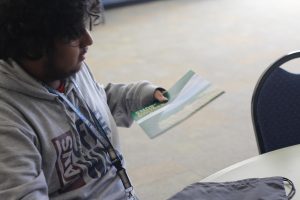Green School gives students a way to get involved with environmental activism
Credit: Elliot Russell
Green School members take an active role in their community, and though attendance is not tracked, students attend regularly. Seen here, they paint slabs of concrete for the A wing courtyard.
October 15, 2021
Loy Norrix has a variety of outdoor spaces, from the spacious and social lunch courtyard, to the smaller, foliage-rich A, B and C wing courtyards, along with the rippling green landscaping around the school. Though a great share of credit is owed to our maintenance and custodial staff, the Green School club is also to thank for many of the natural improvements and conservation in and around our school.
Green School is a nationwide foundation, with schools from all over the country participating in protecting nature and raising awareness of environmental issues.
The Norrix chapter of Green School is one of the older clubs at Norrix, being around since 2014, getting Green School status in the same year. AP Biology teacher Jason Wagner was the original advisor to the club, though the current advisor for Green School is Eric David, a freshman biology teacher.
“I took over being advisor for the club 4 years ago and have been the advisor ever since,” David said.
Michigan Green School was founded in 2005, within the Hartland school district. The requirements to extend this Green School status are strict, with a school having to meet and maintain at least 10 out of 20 points of educational environmental activities within the categories of recycling, energy, environmental protection, and miscellaneous.
Within these categories, Recycling includes activities such as composting food, arranging the purchase of organic food for school lunches and the reuse of school supplies for new purposes. Energy refers to the development of an energy saving program, while environmental protection offers establishment of a garden or lobbying local officials. Finally, the miscellaneous category covers adoption of animals, organizing an Earth Day event and making an information kiosk on environmental information. All of the categories are meant to promote environmental protection and include more than those listed, see the Green School website for full list.
Green School club has done many of these things in previous years to make Norrix a green school in the first place. David said that the branch’s projects have “involved schoolwide clean up projects, invasive species removal, habitats and bay houses and put those up around the school. ”
The club has already planned new projects for the 2021-2022 school year.
“Currently we do bottle and can recycling schoolwide,” David continued. “We help with school clean-up, cleaning up the senior courtyard. We’re also working to renovate the A-wing courtyard with walkways we’ve put in. Planting some perennial species to attract butterflies.
We’re also working on some climate change initiatives, raise awareness for that. We have a lot of other ideas for things we’d like to work on, a lot of things we’d like to do. People want to do with the senior courtyard, more things with invasive species and trash around the community. There’s renewable energy things we could do, maybe solar projects.”
The Green School club clearly has a lot of work ahead of them, but they have come into the year with numbers far greater than before.
David said, “I’d say in 2019 we had 8-10 people showing up regularly, and this year we’ve had at least 20 people showing up regularly.”
The students involved in Green School are enthusiastic for their projects. In meetings, they jump almost immediately to the task at hand and have a genuine interest in the assignments.
Though the club meets in David’s room of B14 and the advisor takes a major place in running and organizing the club, the students within the club take on a lot of responsibility.
Senior Telise Clemente, a student leader within the club, said, “Concerning atmosphere, I feel like Green School is a very casual club. There’s no process to join other than showing up, so anyone is able to try it out and see if what we’re doing speaks to them.”
“Ideally I would like it to be a student-driven club, really run by the students, run by ideas on how they can raise awareness in the school body,” David said.
The atmosphere of the club is productive and cooperative, approaching tasks with energy and a genuine interest in helping to improve their environment. Recently, the group has been focused on the A-wing courtyard, planning to put down a path of painted slabs and introduce new greenery to it.
Clemente said, “I was so surprised by how many people were excited to get their hands dirty and how much we could get done when we worked together.”
The future looks bright for the club, with active participation by greater numbers than ever before, enthusiastic work on visible projects, and a supportive advisor.
“I think the biggest positive is that every time we finish a meeting, I feel like we’ve gotten something done and made some type of change,” Clemente said. “No matter how small.”













